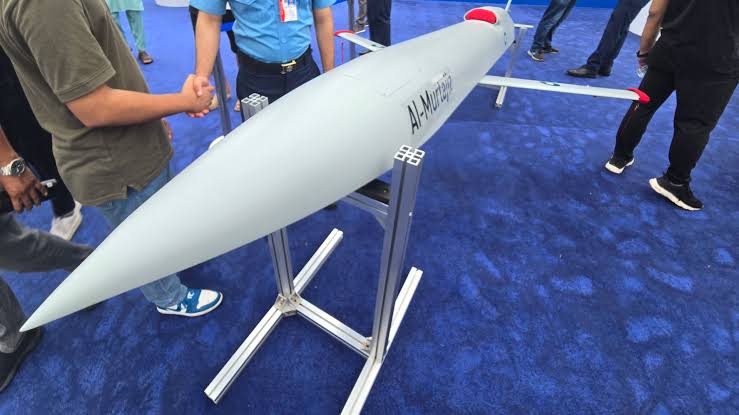By Major (R) Haroon Rasheed, Defense and Strategic Analyst, Member REC-ABAD.
Introduction
On the evolving battlefield of the 21st century, technology and doctrine are rapidly converging to reshape the balance of power. Pakistan’s recent unveiling of the Al-Murtajiz loitering munition and the Pakistan Air Force’s (PAF) steady transition towards Manned-Unmanned Teaming (MUM-T) represent landmark developments in South Asia’s strategic environment.
These advancements not only reflect Pakistan’s determination to strengthen its indigenous defense capabilities but also highlight its adaptability in modern warfare, where artificial intelligence (AI), autonomy, and precision strike capabilities dictate superiority.
Al-Murtajiz Loitering Munition — An Overview
The newly unveiled Al-Murtajiz is Pakistan’s first indigenously developed loitering munition, also commonly referred to as a “suicide drone” or kamikaze UAV. Unlike conventional missiles, loitering munitions can remain airborne for extended periods, surveil the battlespace, and engage targets with pinpoint accuracy once identified.
Key features of Al-Murtajiz include
Autonomous Loitering: Capable of circling over the battlefield for hours before engaging targets.
Precision Strike: Designed to hit high-value assets such as enemy air defense systems, command posts, and armored vehicles.
Low Radar Signature: Its small size and composite build allow it to evade detection by enemy radars.
Cost Efficiency: A cheaper alternative to cruise missiles, allowing saturation attacks against critical nodes.
Network-Centric Capability: Integration with Pakistan’s emerging C4ISR network enables coordinated strikes in conjunction with UAVs, manned aircraft, and ground forces.
The Al-Murtajiz, by design, is not just a weapon but a tactical game-changer. It provides Pakistan with the ability to degrade enemy air defenses prior to a major aerial offensive, disrupt command structures, and impose a constant psychological and operational burden on adversaries.
MUM-T and the Future of the Pakistan Air Force
Parallel to Al-Murtajiz’s induction, the Pakistan Air Force is gradually transforming its combat doctrine by moving towards Manned-Unmanned Teaming (MUM-T). This concept involves the seamless integration of manned fighter jets with unmanned aerial systems (UAS) in the same operational battlespace.
For example, JF-17 Thunder or J-10C pilots could command multiple drones or loitering munitions like Al-Murtajiz in real time. These drones could act as:
Scouts to extend sensor range and identify threats.
Loyal Wingmen to provide electronic warfare cover or suppress enemy air defenses.
Strike Assets to engage high-value targets without risking pilots or expensive aircraft.
By adopting MUM-T, PAF is ensuring that quality, not quantity, dictates the balance of power. In a region where adversaries have numerical superiority, Pakistan is leveraging technology, AI, and network-centric warfare to neutralize that imbalance.
Geo-Strategic Importance
The unveiling of Al-Murtajiz and PAF’s doctrinal shift hold significant implications for South Asian security:
1. Countering India’s Technological Edge: India has been investing heavily in drones, swarm systems, and Israeli-origin loitering munitions. Al-Murtajiz closes this gap and signals Pakistan’s determination to remain technologically competitive.
2. Deterrence by Denial: Loitering munitions offer Pakistan the ability to deny adversary freedom of movement in contested areas such as Kashmir or the Western border, thereby strengthening deterrence.
3. Asymmetric Warfare Advantage: Against a numerically larger adversary, Pakistan’s reliance on cost-effective, smart, and precise systems shifts the advantage towards agility and unpredictability.
4. Export Potential and Defense Diplomacy: Al-Murtajiz also positions Pakistan as a future supplier of affordable loitering systems to friendly states, enhancing defense diplomacy and strengthening allalliances.
Conclusion
The induction of Al-Murtajiz loitering munition and the gradual integration of MUM-T reflect Pakistan’s clear strategic vision: adapting to the demands of future warfare. By focusing on indigenous capability, cost-effectiveness, and network-centric operations, Pakistan is ensuring that its armed forces remain relevant, capable, and resilient against both conventional and hybrid threats.
In the broader geo-strategic landscape, these advancements not only secure Pakistan’s defense but also contribute to regional stability by reinforcing deterrence. In the age of intelligent warfare, Al-Murtajiz stands as both a symbol of Pakistan’s technological maturity and a harbinger of its evolving combat doctrine.
Major (R) Haroon Rasheed is a defense and strategic analyst specializing in South Asian military dynamics, deterrence strategy, and defense modernization. He is a member of the Research and Evaluation Cell for Advancing Basic Amenities and Development (REC ABAD).
Stay tuned to Baaghi TV for more. Download our app for the latest news, updates and interesting content!






